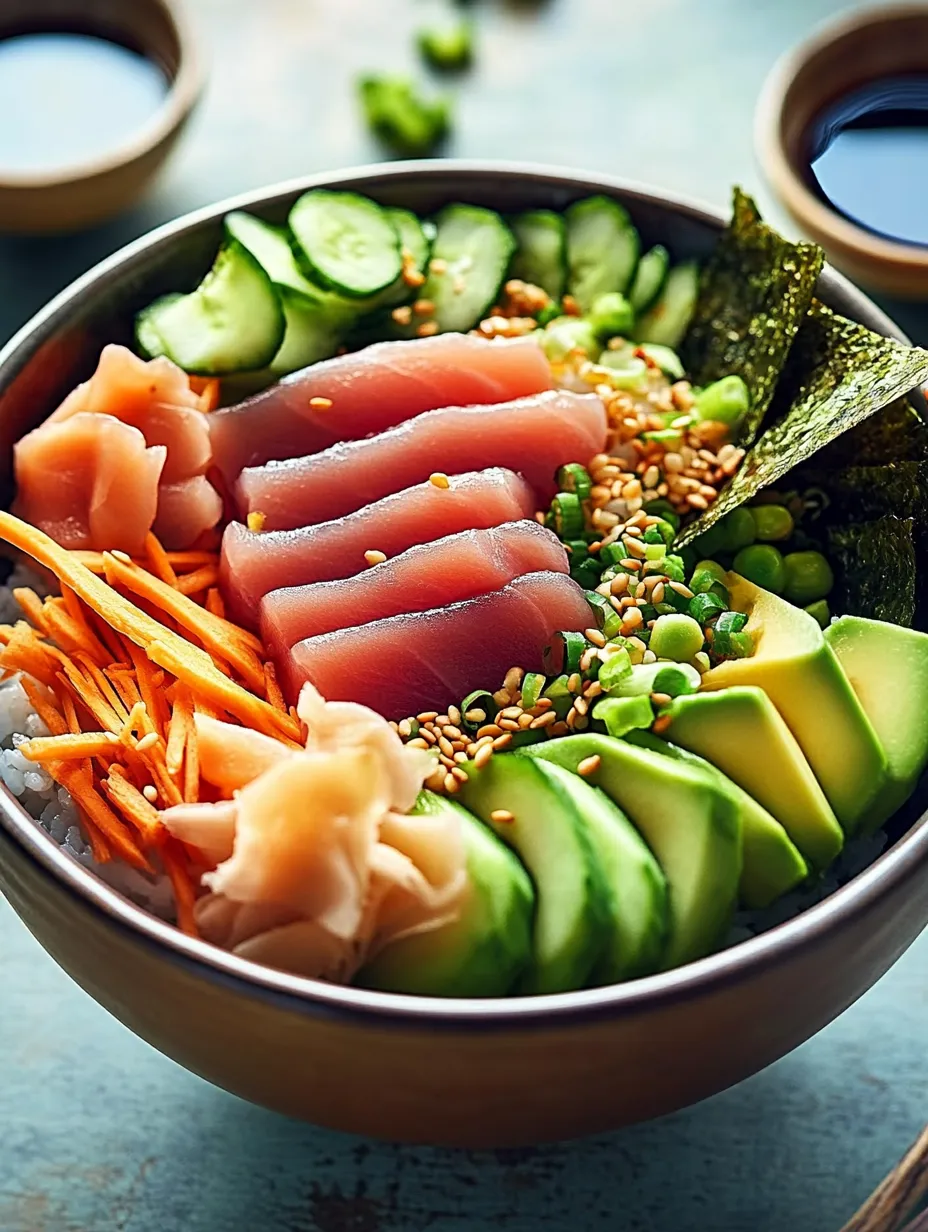 Pin it
Pin it
This homemade sushi bowl brings the flavors of your favorite sushi restaurant right to your kitchen table. I've been making these colorful bowls for years as a way to satisfy my sushi cravings without the hassle of rolling traditional maki. The beauty of this dish lies in its simplicity and adaptability, allowing you to customize it to your family's preferences while maintaining that authentic Japanese flavor profile.
I first created this recipe during a particularly busy work week when I was craving sushi but didn't have time to visit my favorite Japanese restaurant. What started as a quick dinner solution has become a weekly staple in our home, with my children now requesting "build your own sushi bowl" nights where everyone customizes their creation.
Ingredients
- Sushi Rice: Short grain Japanese rice creates the proper sticky texture essential for authentic flavor
- Rice Vinegar Mixture: Creates that distinctive tangy sweetness that defines sushi rice
- Fresh Salmon or Tuna: Choose sushi grade fish for the best flavor and food safety
- Avocado: Provides creamy richness that complements the fish perfectly
- Cucumber: Adds essential crunch and freshness to balance the rich components
- Carrots: Sweet crispness that brightens each bite
- Nori Sheets: Delivers authentic ocean flavor that makes the dish truly reminiscent of sushi
- Soy Sauce: Provides that essential umami foundation
- Spicy Mayo: Creates a luxurious finish that brings all elements together
- Sesame Seeds: Adds texture and a nutty finish that elevates the entire dish
Step-by-Step Instructions
- Prepare The Rice:
- Rinse short grain rice repeatedly until water runs clear. This removes excess starch that would make your rice gummy rather than properly sticky. Cook according to package directions, then transfer to a wide shallow bowl. Mix rice vinegar, sugar and salt in a small bowl until dissolved, then gently fold into the hot rice using a cutting motion to avoid crushing the grains. Fan the rice gently while mixing to create the characteristic glossy finish. Let cool to room temperature.
- Slice The Protein:
- For raw fish, ensure it's sushi grade quality from a reputable fishmonger. Place the fish in the freezer for 15 minutes before slicing to firm it up slightly, making clean cuts easier. Use a very sharp knife to cut against the grain into thin slices or small cubes. If using cooked protein like shrimp or tofu, prepare according to your preference and slice into bite sized pieces.
- Prepare Fresh Components:
- Slice avocado just before serving to prevent browning. Cut cucumber into thin matchsticks or half moons. Julienne carrots or use a vegetable peeler to create delicate ribbons. Slice nori sheets into thin strips using kitchen scissors. Prepare any additional toppings like thinly sliced radish, edamame, or pickled ginger.
- Assemble Your Bowl:
- Start with a generous portion of room temperature sushi rice as your base. Arrange your protein and vegetables in sections around the bowl rather than mixing them together. This presentation not only looks beautiful but allows you to experience different flavor combinations with each bite. Place a few nori strips standing upright in the rice for height and texture.
- Add Final Touches:
- Drizzle your favorite sauces around the bowl. I typically use a combination of spicy mayo, unagi sauce, and a light touch of soy sauce. Sprinkle with sesame seeds, sliced green onions, and a small dab of wasabi if desired. For extra crunch, add tempura flakes or crispy shallots as a finishing touch.
 Pin it
Pin it
The absolute game changer in this recipe is the proper preparation of the sushi rice. Many home cooks skip the vinegar seasoning step, but this is what transforms plain rice into proper sushi rice with that distinctive flavor. My grandmother taught me to use a wooden bowl called a hangiri for cooling the rice, but any wide shallow bowl works well. Just remember to treat the rice gently and avoid refrigerating it, as cold temperatures ruin the texture.
Storage Tips
Sushi bowls are best enjoyed immediately after assembly, as the textures and flavors are at their peak freshness. However, you can prepare components ahead of time for quick assembly. Store cooked sushi rice at room temperature covered with a damp towel for up to 6 hours. For meal prep, store all components separately in airtight containers, with rice and vegetables lasting up to 3 days in the refrigerator. Consume sushi grade fish within 24 hours of purchase for optimal safety and flavor.
 Pin it
Pin it
Ingredient Substitutions
Sushi bowls are incredibly forgiving and adaptable to what you have on hand. Brown rice can replace white sushi rice for added fiber, though the texture will be different. For a budget friendly option, canned tuna mixed with mayo and sriracha makes a delicious alternative to fresh fish. Plant based eaters can use marinated tofu, tempeh or even roasted mushrooms seasoned with furikake for an umami rich protein replacement. Those avoiding rice entirely can use cauliflower rice or thinly sliced cucumber as a refreshing base.
Serving Suggestions
Present your sushi bowls with small dishes of additional soy sauce, wasabi, and pickled ginger on the side so guests can adjust flavors to their preference. Pair with a simple miso soup for a complete meal experience. For entertaining, consider creating a DIY sushi bowl bar where guests can assemble their own creations. This interactive dining experience has been a huge hit at my dinner parties. Complete the meal with a light dessert like mochi ice cream or fresh fruit to cleanse the palate.
Frequently Asked Questions
- → What type of rice is best for sushi bowls?
Sushi rice, a short-grain rice seasoned with rice vinegar, sugar, and salt, is the best choice for authentic flavor and texture.
- → Can I use cooked protein instead of raw fish?
Absolutely! Cooked options like shrimp, crab, or even tofu are delicious alternatives to raw fish in sushi bowls.
- → How can I ensure the fish is safe to eat raw?
Look for sushi-grade fish, which is safe for raw consumption. Check with your local fishmonger to ensure the highest quality.
- → What are some popular sauce choices for sushi bowls?
Popular sauces include spicy mayo, soy sauce, ponzu, sriracha, or sesame-ginger dressing to add flavor and moisture.
- → Are sushi bowls suitable for vegans?
Yes! Use plant-based proteins like tofu or tempeh, and load up on vegetables like avocado, edamame, and cucumber, finishing with a soy-based sauce.
- → What are some toppings to enhance sushi bowls?
Add sesame seeds, pickled ginger, wasabi, green onions, or thinly sliced nori for extra texture and flavor.
